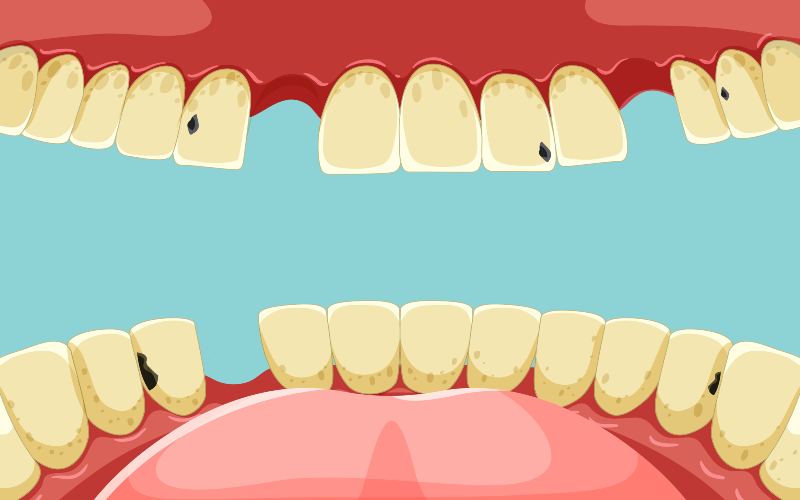Study suggests gum disease may signal brain injury and stroke risk

The findings indicate that chronic inflammation from gum disease may not remain confined to the mouth but could affect the brain through inflammatory pathways or by allowing bacteria and toxins into the bloodstream.
Poor gum health may be linked to changes in the brain, signs that could indicate injury or damage, according to a study published in Neurology.
Researchers found that older adults with gum disease were more likely to show white matter hyperintensities, which appear as bright spots on brain scans and indicate damage to nerve fibres that help different regions of the brain communicate.
More To Read
- Beyond Sugar: Common foods linked to baby tooth decay
- African health ministers adopt regional framework to fight oral diseases
- Hidden cost of tooth pain: Why many endure toothaches instead of seeking treatment
- Dental care in Kenya: High costs and tradition limit access to essential oral health services
- ‘Caday’: The enduring natural toothbrush preferred by Somalis
These changes are associated with problems in memory, balance, and coordination, and may also raise the risk of stroke.
The findings published in Neurology Open Access revealed that these white matter changes, known as white matter hyperintensities, appear as bright spots on brain scans and are believed to indicate tissue injury.
According to the World Health Organisation (WHO), poor gum (periodontal) health begins with inflammation (gingivitis) and can progress to periodontitis, involving loss of the connective tissue and bone supporting the teeth. Persistently swollen gums that bleed easily and deteriorating bone and ligaments reflect poor gum health under the WHO’s oral-health framework.
White matter acts like the brain’s wiring, connecting different parts to enable clear thinking, memory, balance, and decision-making. Gum disease causes chronic inflammation and allows bacteria to enter the bloodstream, potentially reaching the brain and damaging white matter. This may slow thinking, impair memory, and affect movement.
Taking care of teeth and gums, through brushing, flossing, and regular dental checkups, may help protect not only oral health but also brain function. In simple terms, a healthy mouth can support a healthy brain.
White matter hyperintensities are common in older adults and are thought to reflect subtle brain injury related to blood vessel health or inflammation. The study suggests oral health may influence brain health in ways that are only beginning to be understood. While more research is needed, the findings add to growing evidence that good oral hygiene could support cognitive health.
The research involved 1,143 adults with an average age of 77. Each underwent a dental exam and brain scan. Of these, 800 had gum disease and 343 did not. Brain scans looked for signs of cerebral small vessel disease, which affects tiny blood vessels in the brain and can present as white matter hyperintensities, cerebral microbleeds, or lacunar infarcts, changes linked to ageing, memory decline, stroke, and movement issues.
On average, participants with gum disease had white matter hyperintensities covering 2.83 per cent of their brain volume, compared to 2.52 per cent among those without gum disease. Participants were grouped by the extent of white matter damage, with the highest group having more than 21.36 cubic centimetres (cm³) of hyperintensities and the lowest group less than 6.41 cm³.
Among those with gum disease, 28 per cent fell into the highest category, compared to 19 per cent of those without it. Even after adjusting for age, sex, race, high blood pressure, diabetes, and smoking, gum disease was linked to a 56 per cent higher likelihood of being in the group with the most extensive white matter damage.
However, the study did not find a significant link between gum disease and other brain abnormalities related to small vessel disease, such as cerebral microbleeds and lacunar infarcts.
Researchers emphasised that gum disease is both preventable and treatable.
If future studies confirm this link, targeting oral inflammation could offer a new strategy for reducing cerebral small vessel disease. For now, the findings highlight the potential importance of dental care in maintaining long-term brain health.
One limitation of the study was that dental assessments and brain scans were conducted only once, making it impossible to track changes over time. Still, the results suggest a meaningful connection between oral health and brain function that warrants further exploration.
The findings indicate that chronic inflammation from gum disease may not remain confined to the mouth but could affect the brain through inflammatory pathways or by allowing bacteria and toxins into the bloodstream. Because white matter is critical for communication between brain regions, any damage can have serious consequences, including memory loss, impaired balance, and increased stroke risk.
Although the study did not establish a direct cause-and-effect relationship, the consistent association between gum disease and white matter damage suggests oral inflammation might be an overlooked factor in brain health. It underscores the importance of viewing oral hygiene as part of overall health.
From a broader perspective, maintaining healthy gums through regular dental care may offer benefits beyond the mouth. If future research confirms this link, preventing and treating gum disease could become a strategy for reducing age-related brain changes and lowering the risk of stroke and cognitive decline.
Top Stories Today












































